Page 233 of 354
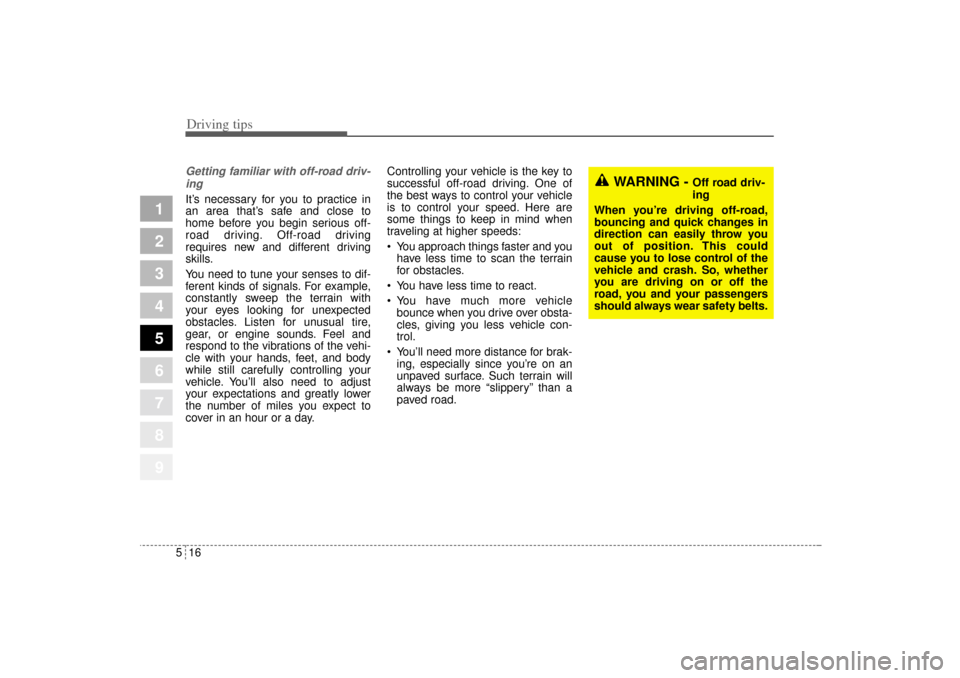
Driving tips16 5
1
2
3
4
5
6
7
8
9
Getting familiar with off-road driv-
ingIt’s necessary for you to practice in
an area that’s safe and close to
home before you begin serious off-
road driving. Off-road driving
requires new and different driving
skills.
You need to tune your senses to dif-
ferent kinds of signals. For example,
constantly sweep the terrain with
your eyes looking for unexpected
obstacles. Listen for unusual tire,
gear, or engine sounds. Feel and
respond to the vibrations of the vehi-
cle with your hands, feet, and body
while still carefully controlling your
vehicle. You’ll also need to adjust
your expectations and greatly lower
the number of miles you expect to
cover in an hour or a day.Controlling your vehicle is the key to
successful off-road driving. One of
the best ways to control your vehicle
is to control your speed. Here are
some things to keep in mind when
traveling at higher speeds:
You approach things faster and you
have less time to scan the terrain
for obstacles.
You have less time to react.
You have much more vehicle
bounce when you drive over obsta-
cles, giving you less vehicle con-
trol.
You’ll need more distance for brak-
ing, especially since you’re on an
unpaved surface. Such terrain will
always be more “slippery” than a
paved road.
WARNING -
Off road driv-
ing
When you’re driving off-road,
bouncing and quick changes in
direction can easily throw you
out of position. This could
cause you to lose control of the
vehicle and crash. So, whether
you are driving on or off the
road, you and your passengers
should always wear safety belts.
KM CAN (ENG) 5.qxd 9/13/2004 4:48 PM Page 16
Page 235 of 354
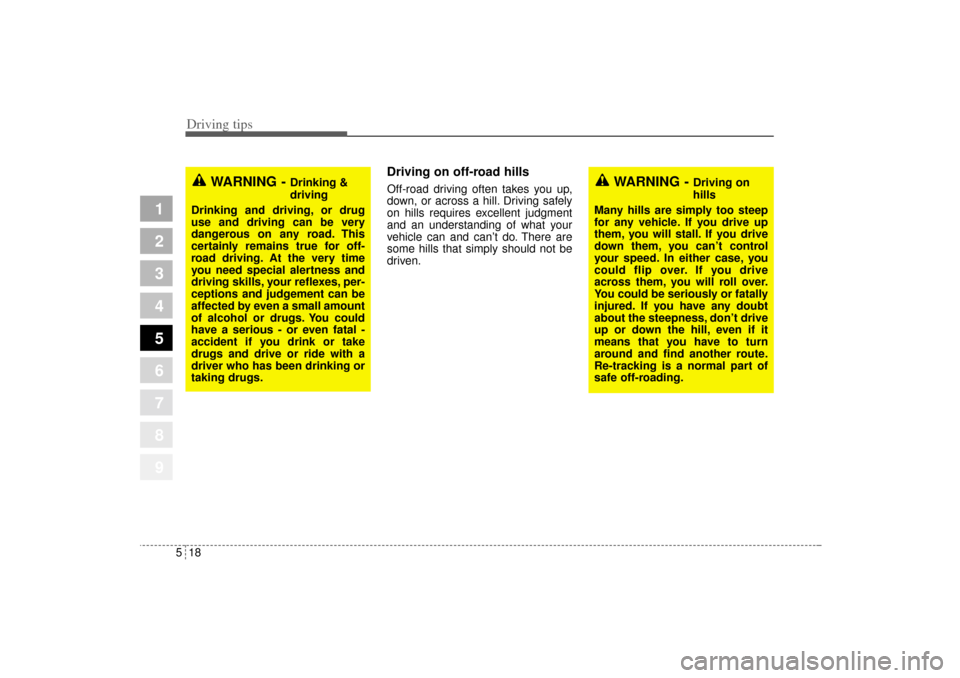
Driving tips18 5
1
2
3
4
5
6
7
8
9
Driving on off-road hillsOff-road driving often takes you up,
down, or across a hill. Driving safely
on hills requires excellent judgment
and an understanding of what your
vehicle can and can’t do. There are
some hills that simply should not be
driven.
WARNING -
Drinking &
driving
Drinking and driving, or drug
use and driving can be very
dangerous on any road. This
certainly remains true for off-
road driving. At the very time
you need special alertness and
driving skills, your reflexes, per-
ceptions and judgement can be
affected by even a small amount
of alcohol or drugs. You could
have a serious - or even fatal -
accident if you drink or take
drugs and drive or ride with a
driver who has been drinking or
taking drugs.
WARNING -
Driving on
hills
Many hills are simply too steep
for any vehicle. If you drive up
them, you will stall. If you drive
down them, you can’t control
your speed. In either case, you
could flip over. If you drive
across them, you will roll over.
You could be seriously or fatally
injured. If you have any doubt
about the steepness, don’t drive
up or down the hill, even if it
means that you have to turn
around and find another route.
Re-tracking is a normal part of
safe off-roading.
KM CAN (ENG) 5.qxd 9/13/2004 4:48 PM Page 18
Page 237 of 354
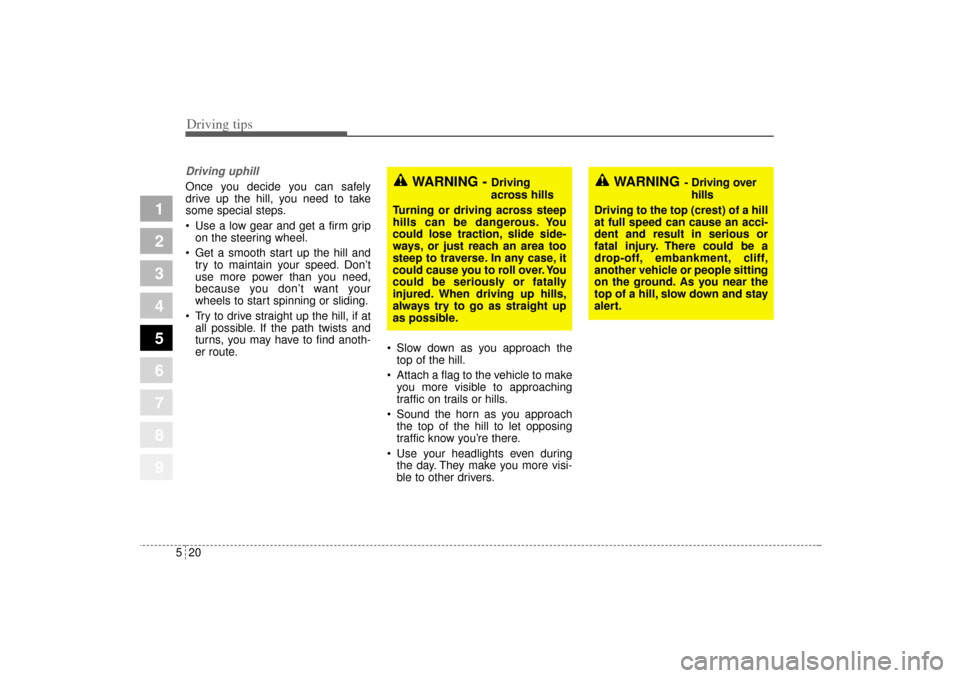
Driving tips20 5
1
2
3
4
5
6
7
8
9
Driving uphillOnce you decide you can safely
drive up the hill, you need to take
some special steps.
Use a low gear and get a firm grip
on the steering wheel.
Get a smooth start up the hill and
try to maintain your speed. Don’t
use more power than you need,
because you don’t want your
wheels to start spinning or sliding.
Try to drive straight up the hill, if at
all possible. If the path twists and
turns, you may have to find anoth-
er route. Slow down as you approach the
top of the hill.
Attach a flag to the vehicle to make
you more visible to approaching
traffic on trails or hills.
Sound the horn as you approach
the top of the hill to let opposing
traffic know you’re there.
Use your headlights even during
the day. They make you more visi-
ble to other drivers.
WARNING -
Driving
across hills
Turning or driving across steep
hills can be dangerous. You
could lose traction, slide side-
ways, or just reach an area too
steep to traverse. In any case, it
could cause you to roll over. You
could be seriously or fatally
injured. When driving up hills,
always try to go as straight up
as possible.
WARNING
- Driving over
hills
Driving to the top (crest) of a hill
at full speed can cause an acci-
dent and result in serious or
fatal injury. There could be a
drop-off, embankment, cliff,
another vehicle or people sitting
on the ground. As you near the
top of a hill, slow down and stay
alert.
KM CAN (ENG) 5.qxd 9/13/2004 4:48 PM Page 20
Page 239 of 354
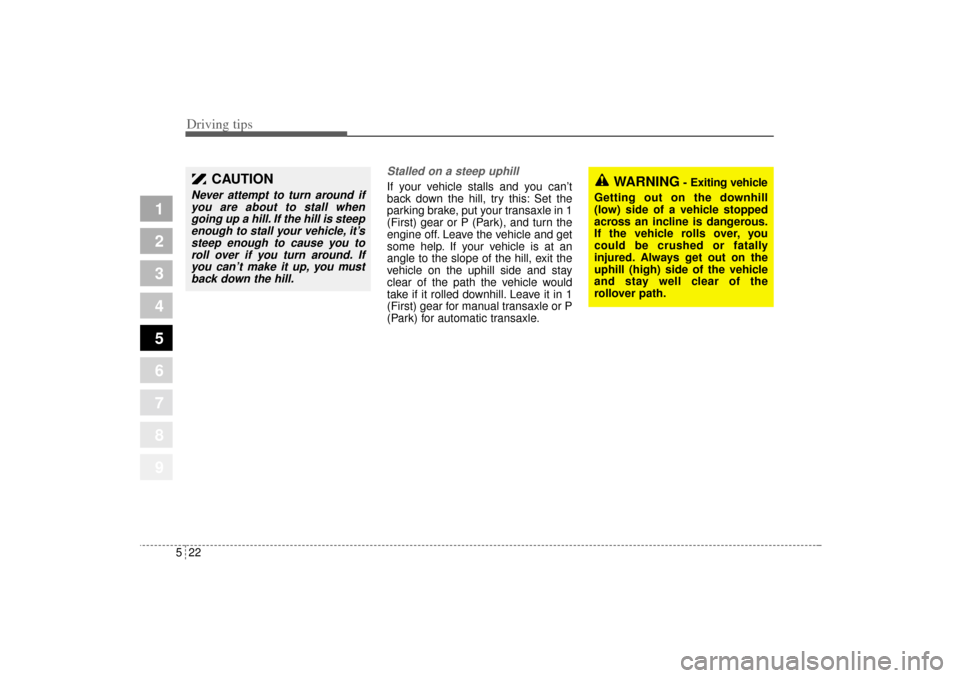
Driving tips22 5
1
2
3
4
5
6
7
8
9
Stalled on a steep uphillIf your vehicle stalls and you can’t
back down the hill, try this: Set the
parking brake, put your transaxle in 1
(First) gear or P (Park), and turn the
engine off. Leave the vehicle and get
some help. If your vehicle is at an
angle to the slope of the hill, exit the
vehicle on the uphill side and stay
clear of the path the vehicle would
take if it rolled downhill. Leave it in 1
(First) gear for manual transaxle or P
(Park) for automatic transaxle.
CAUTION
Never attempt to turn around if
you are about to stall when
going up a hill. If the hill is steep
enough to stall your vehicle, it’s
steep enough to cause you to
roll over if you turn around. If
you can’t make it up, you must
back down the hill.
WARNING
- Exiting vehicle
Getting out on the downhill
(low) side of a vehicle stopped
across an incline is dangerous.
If the vehicle rolls over, you
could be crushed or fatally
injured. Always get out on the
uphill (high) side of the vehicle
and stay well clear of the
rollover path.
KM CAN (ENG) 5.qxd 9/13/2004 4:48 PM Page 22
Page 240 of 354
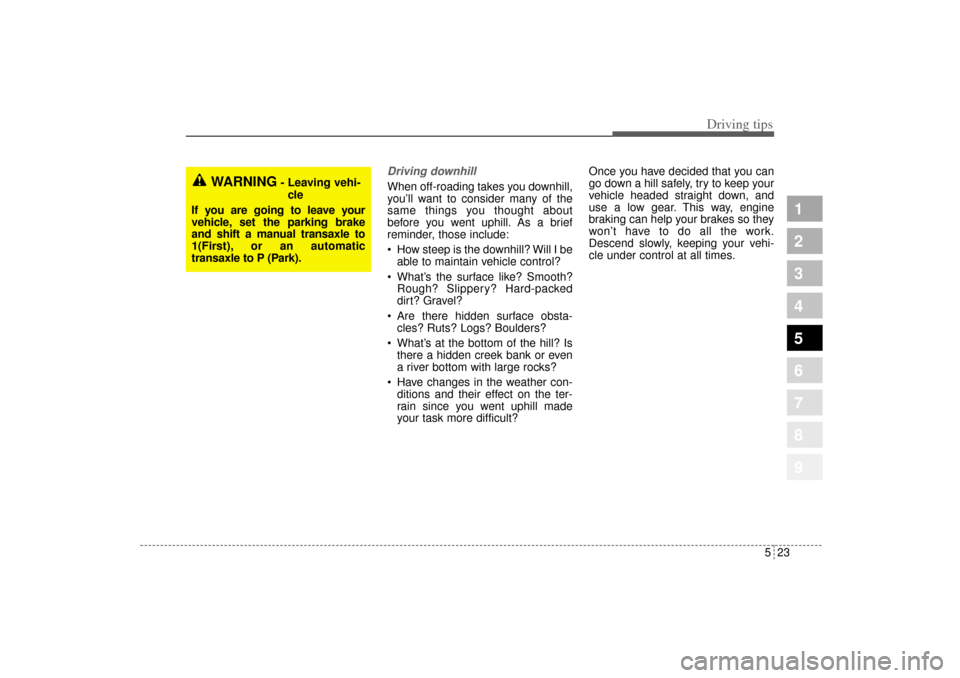
523
Driving tips
1
2
3
4
5
6
7
8
9
Driving downhillWhen off-roading takes you downhill,
you’ll want to consider many of the
same things you thought about
before you went uphill. As a brief
reminder, those include:
How steep is the downhill? Will I be
able to maintain vehicle control?
What’s the surface like? Smooth?
Rough? Slippery? Hard-packed
dirt? Gravel?
Are there hidden surface obsta-
cles? Ruts? Logs? Boulders?
What’s at the bottom of the hill? Is
there a hidden creek bank or even
a river bottom with large rocks?
Have changes in the weather con-
ditions and their effect on the ter-
rain since you went uphill made
your task more difficult?Once you have decided that you can
go down a hill safely, try to keep your
vehicle headed straight down, and
use a low gear. This way, engine
braking can help your brakes so they
won’t have to do all the work.
Descend slowly, keeping your vehi-
cle under control at all times.
WARNING
- Leaving vehi-
cle
If you are going to leave your
vehicle, set the parking brake
and shift a manual transaxle to
1(First), or an automatic
transaxle to P (Park).
KM CAN (ENG) 5.qxd 9/13/2004 4:48 PM Page 23
Page 241 of 354
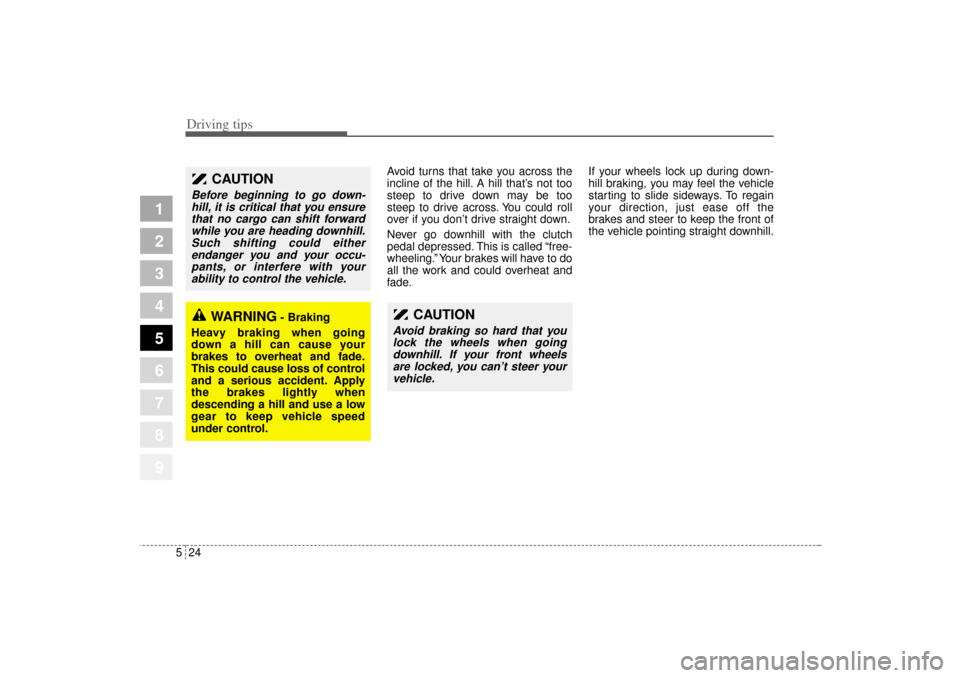
Driving tips24 5
1
2
3
4
5
6
7
8
9
Avoid turns that take you across the
incline of the hill. A hill that’s not too
steep to drive down may be too
steep to drive across. You could roll
over if you don’t drive straight down.
Never go downhill with the clutch
pedal depressed. This is called “free-
wheeling.” Your brakes will have to do
all the work and could overheat and
fade.If your wheels lock up during down-
hill braking, you may feel the vehicle
starting to slide sideways. To regain
your direction, just ease off the
brakes and steer to keep the front of
the vehicle pointing straight downhill.
CAUTION
Before beginning to go down-
hill, it is critical that you ensure
that no cargo can shift forward
while you are heading downhill.
Such shifting could either
endanger you and your occu-
pants, or interfere with your
ability to control the vehicle.
WARNING
- Braking
Heavy braking when going
down a hill can cause your
brakes to overheat and fade.
This could cause loss of control
and a serious accident. Apply
the brakes lightly when
descending a hill and use a low
gear to keep vehicle speed
under control.
CAUTION
Avoid braking so hard that you
lock the wheels when going
downhill. If your front wheels
are locked, you can’t steer your
vehicle.
KM CAN (ENG) 5.qxd 9/13/2004 4:48 PM Page 24
Page 243 of 354
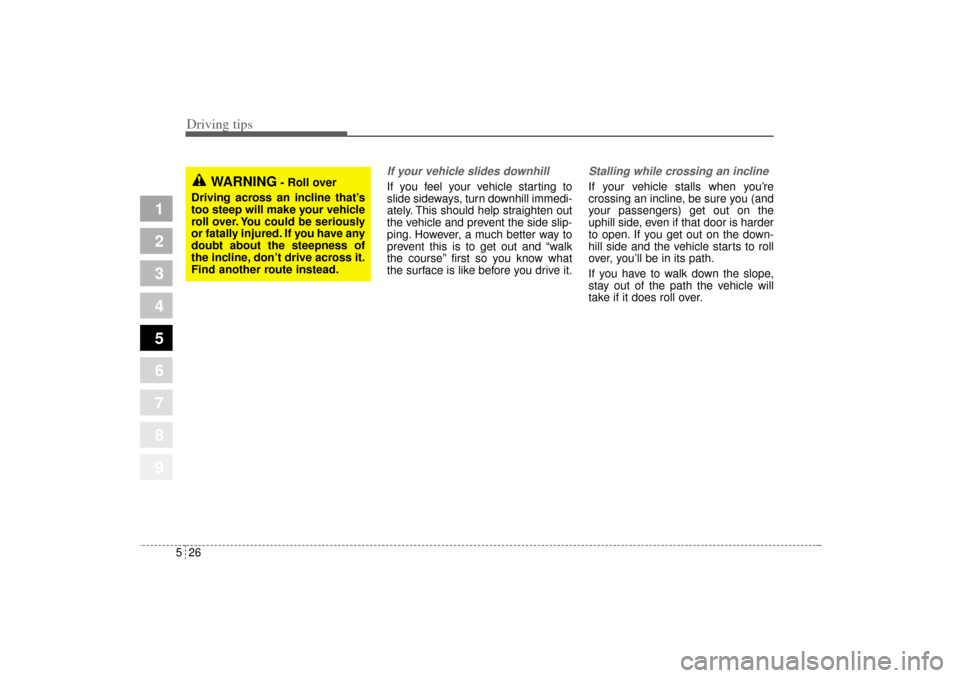
Driving tips26 5
1
2
3
4
5
6
7
8
9
If your vehicle slides downhillIf you feel your vehicle starting to
slide sideways, turn downhill immedi-
ately. This should help straighten out
the vehicle and prevent the side slip-
ping. However, a much better way to
prevent this is to get out and “walk
the course” first so you know what
the surface is like before you drive it.
Stalling while crossing an inclineIf your vehicle stalls when you’re
crossing an incline, be sure you (and
your passengers) get out on the
uphill side, even if that door is harder
to open. If you get out on the down-
hill side and the vehicle starts to roll
over, you’ll be in its path.
If you have to walk down the slope,
stay out of the path the vehicle will
take if it does roll over.
WARNING
- Roll over
Driving across an incline that’s
too steep will make your vehicle
roll over. You could be seriously
or fatally injured. If you have any
doubt about the steepness of
the incline, don’t drive across it.
Find another route instead.
KM CAN (ENG) 5.qxd 9/13/2004 4:48 PM Page 26
Page 244 of 354

527
Driving tips
1
2
3
4
5
6
7
8
9
Driving in mud, sand, snow, or
iceWhen you drive in mud, sand, snow,
or ice, your wheels won’t get good
traction. You can’t accelerate as
quickly, turning is more difficult, and
you’ll need longer braking distances.
It’s best to use a low gear when
you’re in mud, the deeper the mud,
the lower the gear. In extremely deep
mud, the idea is to keep your vehicle
moving so you don’t get stuck.
When you drive on sand, you’ll
sense a change in wheel traction.
But it will depend upon how loosely
packed the sand is. On loosely
packed sand (as on beaches or sand
dunes) your tires will tend to sink into
the sand. This has an effect on steer-
ing, accelerating, and braking. You
may want to reduce the air pressure
in your tires slightly when driving on
sand. This will improve traction.
Remember to re-inflate them the first
chance that you have after you leave
the loosely packed sand.
✽ ✽
NOTICE• In case of loss of traction in mud,
loose soil, or sand, turn the steer-
ing wheel rapidly from side-to-
side. This can help generate addi-
tional traction.
• Do not gun the engine. This will
cause the tires to spin and dig
down, not forward, and could
bury the vehicle to the frame.
Smooth, easy power is better than
too much power.
WARNING
- Exiting vehi-
cle
Getting out on the downhill
(low) side of a vehicle stopped
across an incline is dangerous.
If the vehicle rolls over, you
could be crushed or fatally
injured. Always get out on the
uphill (high) side of the vehicle
and stay well clear of the
rollover path.
KM CAN (ENG) 5.qxd 9/13/2004 4:48 PM Page 27